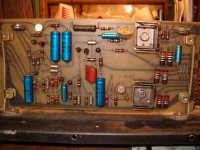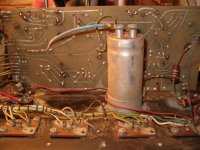I did post this in the Instrument Amp forum but realized this is more the correct forum
for repair info.
Trying to bring a Acoustic 260 head back to life.
Had a blown fuse, replaced fuse and plugged it using my light bulb series power tester, bulb
stays fully lit.
Pull all four of the output transistors, easy to do as they are plug in socket mounted, short
is gone, bulb briefly lights bright and fades down to barely glowing.
Using a multimeter in diode test mode all transistors show they should be good.
Checked the two driver transistors the same way and they check good as well.
Output transistors are 40411 NPN RCA's
Anyone else dove into one these, schematics seem to be non existent,
Would it be worth just replacing the outputs with something like a set of MJ15024 or 2N3773 transistors and see
where that takes me?
Mike C.
for repair info.
Trying to bring a Acoustic 260 head back to life.
Had a blown fuse, replaced fuse and plugged it using my light bulb series power tester, bulb
stays fully lit.
Pull all four of the output transistors, easy to do as they are plug in socket mounted, short
is gone, bulb briefly lights bright and fades down to barely glowing.
Using a multimeter in diode test mode all transistors show they should be good.
Checked the two driver transistors the same way and they check good as well.
Output transistors are 40411 NPN RCA's
Anyone else dove into one these, schematics seem to be non existent,
Would it be worth just replacing the outputs with something like a set of MJ15024 or 2N3773 transistors and see
where that takes me?
Mike C.
Did you ohm test from C to E?
Sometimes that shorts due to excessive current, but leaves the two PN junctions ok.
Sometimes that shorts due to excessive current, but leaves the two PN junctions ok.
Yep, C to E , positive on C all read open, negative on C two read open and two read around 10 meg.
With all the outputs removed, is there DC on the speaker terminals?
Also test for ohmic shorts from each socket terminal to sink while the transistors are out.
Also test for ohmic shorts from each socket terminal to sink while the transistors are out.
What to “watch out for” depends highly on the amplifier topology. Those 40411 outputs were used extensively in the days of the old transformer-driven totem pole output stages. Any idea as to whether you’re dealing with one of those, or a quasi-comp with old complementary TO-5 drivers?
Those amps have a large blocking cap on the output, the Acoustic amps were only a single 70 volt power rail design,With all the outputs removed, is there DC on the speaker terminals?
Also test for ohmic shorts from each socket terminal to sink while the transistors are out.
so the blocking cap is very necessary. I will check before the cap with the outputs pulled.
The drivers TO5's 40410 and 40409.What to “watch out for” depends highly on the amplifier topology. Those 40411 outputs were used extensively in the days of the old transformer-driven totem pole output stages. Any idea as to whether you’re dealing with one of those, or a quasi-comp with old complementary TO-5 drivers?
So it’s a “regular” quasi-comp amplifier. It’s quite possible that it will “work” properly into a high impedance load (say 1 or 2K ohms) without any output transistors at all. That will let you rule out other faults before putting in new ones.
A couple top and bottom real closeup pictures (board almost filling screen) will definitely help.
Model 260 WAS used, even by fmous Musicians, but is somewhat obscure; the schematic which pops out all the time is that of 270, which may or may not be close, we need those pictures.
Model 260 WAS used, even by fmous Musicians, but is somewhat obscure; the schematic which pops out all the time is that of 270, which may or may not be close, we need those pictures.
https://www.yumpu.com/ro/document/read/10433400/acoustic-260-261-262-service-manual
pain in the butt to download
butt to download
but view able online.
I have a copy of the PDF which I downloaded
to large for attachments apparently
pain in the
 butt to download
butt to downloadbut view able online.
I have a copy of the PDF which I downloaded
to large for attachments apparently
I was under the impression the output were gone and the drivers checked ok. If the quiescent bias circuit isn’t broken and drivers are ok, but outputs shorted all it needs is a new set of outputs. Brought up slow, on a dim bulb, of course. If the outputs actually check ok then dig for oscillations.
Replacing with 2N3773 or MJ15024 is fine - usually. In most circuits where the amount of open loop gain is sensible. I get the feeling this probably just has a PNP singleton input stage and boot strapped NPN VAS. If so output transistor change is a slam dunk. If it had 3 or 4 gain stages, maybe an op amp, it might require more meticulous tuning to get stable. But considering the application my guess is not.
Replacing with 2N3773 or MJ15024 is fine - usually. In most circuits where the amount of open loop gain is sensible. I get the feeling this probably just has a PNP singleton input stage and boot strapped NPN VAS. If so output transistor change is a slam dunk. If it had 3 or 4 gain stages, maybe an op amp, it might require more meticulous tuning to get stable. But considering the application my guess is not.
Good tip, with the outputs removed and sending test tone to the amp I get clean signal on the drivers outputs.So it’s a “regular” quasi-comp amplifier. It’s quite possible that it will “work” properly into a high impedance load (say 1 or 2K ohms) without any output transistors at all. That will let you rule out other faults before putting in new ones.
I see 3 output BJT paralleled. At first I would remove the 6 units and put new units only one per rail. If things go well, I complete the 3 per rail. Else I lost only two units. Check decoupling cap (C64) for excesive leakage.
I did find a hair line crack on a trace by shining a flashlight through the circuit board, jumpered over that
.....no change!
.....no change!
Attached are the pictures.A couple top and bottom real closeup pictures (board almost filling screen) will definitely help.
Model 260 WAS used, even by fmous Musicians, but is somewhat obscure; the schematic which pops out all the time is that of 270, which may or may not be close, we need those pictures.
This is actually just the 260 amp module, not the full amp head. Powered speakers are nothing new, Acoustic built powered speakers using just the 260 amp section built on to panel fitted into the back of the speaker.
The idea was use one full amp head and take the line level outs from the head to drive multiple cabinets.
Attachments
Thanks for the link!!https://www.yumpu.com/ro/document/read/10433400/acoustic-260-261-262-service-manual
pain in thebutt to download
but view able online.
I have a copy of the PDF which I downloaded
to large for attachments apparently
- Home
- Amplifiers
- Solid State
- Acoustic 260 shorted outputs??

